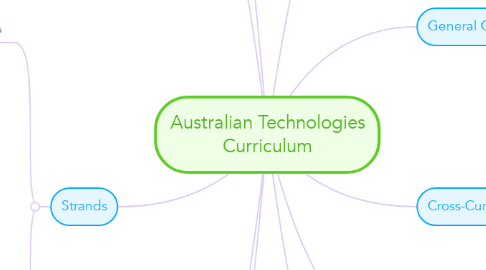
1. Learning Areas
1.1. English
1.2. Mathematics
1.3. Science
1.4. Humanities and Social Sciences
1.5. The Arts
1.6. Technologies
1.7. Health and Physical Education
1.8. Languages
1.9. (Optional) Work Studies
2. General Capabilities
2.1. Literacy
2.2. Numeracy
2.3. Critical and Creative Thinking
2.4. Information and Communication Technology Capability
2.5. Personal and Social Capability
2.6. Ethical Understanding
2.7. Intercultural Understanding
3. Technologies
3.1. Design and Technologies
3.1.1. students use design thinking and technologies to generate and produce designed solutions for authentic needs and opportunities
3.2. Digital Technologies
3.2.1. students use computational thinking and information systems to define, design and implement digital solutions
4. Cross-Curriculum Priorities
4.1. Sustainability
4.2. Asia and Australia's Engagement with Asia
4.3. Aboriginal and Torres Strait Islander histories and cultures
5. Bands
5.1. Foundation - Year 2
5.2. Year 3 and 4
5.3. Year 5 and 6
5.4. Year 7 and 8
5.5. Year 9 and 10
6. Aims
6.1. Technologies aims to develop the knowledge, understanding and skills to ensure that, individually and collaboratively, students:
6.1.1. investigate, design, plan, manage, create and evaluate solutions
6.1.2. are creative, innovative and enterprising when using traditional, contemporary and emerging technologies, and understand how technologies have developed over time
6.1.3. make informed and ethical decisions about the role, impact and use of technologies in the economy, environment and society for a sustainable future
6.1.4. engage confidently with and responsibly select and manipulate appropriate technologies − materials, data, systems, components, tools and equipment − when designing and creating solutions
6.1.5. critique, analyse and evaluate problems, needs or opportunities to identify and create solutions.
7. Key Ideas
7.1. Overarching idea: Creating preferred futures
7.2. Project management
7.3. Systems thinking
7.4. Design thinking
7.5. Computational thinking
7.6. Safety
7.7. Animal ethics
8. Strands
8.1. Design and Technologies
8.1.1. Knowledge and Understanding
8.1.1.1. Technologies and society
8.1.1.2. the use, development and impact of technologies in people’s lives
8.1.1.3. Technologies contexts
8.1.1.4. technologies and design across a range of technologies contexts
8.1.2. Processes and production skills
8.1.2.1. Creating designed solutions by:
8.1.2.2. investigating and defining
8.1.2.3. generating and designing
8.1.2.4. producing and implementing
8.1.2.5. evaluating
8.1.2.6. collaborating and managing
8.2. Digital Technologies
8.2.1. Knowledge and Understanding
8.2.1.1. Digital systems
8.2.1.2. the components of digital systems: hardware, software and networks and their use
8.2.1.3. Representation of data
8.2.1.4. how data are represented and structured symbolically
8.2.2. Processes and production skills
8.2.2.1. Collecting, managing and analysing data
8.2.2.2. Creating digital solutions by:
8.2.2.3. investigating and defining
8.2.2.4. generating and designing
8.2.2.5. producing and implementing
8.2.2.6. evaluating
8.2.2.7. collaborating and managing
9. Student Diversity
9.1. Students with a disability
9.2. Talented and gifted students
9.3. Students that are EAL/D
10. Assessment Practices
10.1. Consistent throughout teaching
10.1.1. Diagnostic
10.1.2. Formative
10.1.3. Summative
